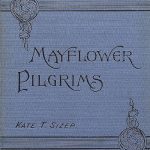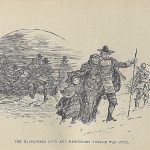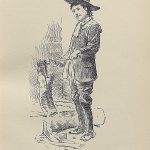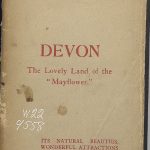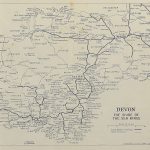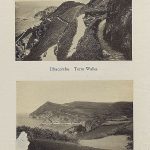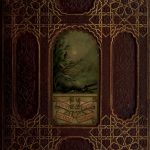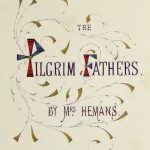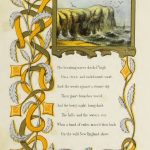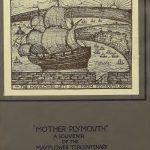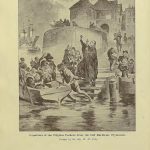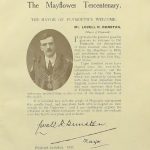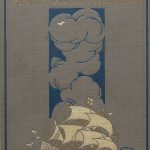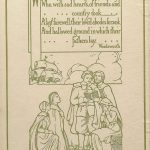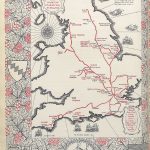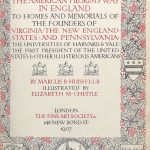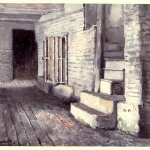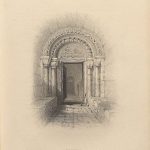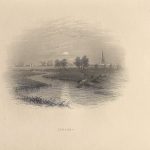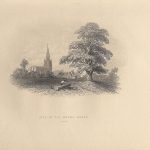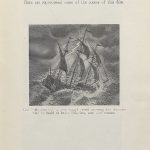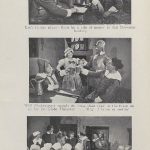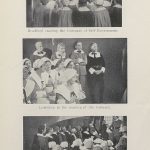Kate Thompson Sizer (1857-1909) was a popular Victorian author who published a number of illustrated children’s books often with a historical setting in the late nineteenth century. Mayflower Pilgrims combines history, illustration, and narrative fiction to create an engaging narrative of escape from persecution. The story focuses on twin sisters named Grace and Annis, their lives in Leiden, Holland, and their adjustment to the fraught early years of New Plymouth. The children come close to starvation, though they ultimately endure such hardships to help create a prosperous community.
Mayflower Books
Great Western Railway, Devon, The Lovely Land of the Mayflower (1923)
Sold at Paddington Station in 1923, this is a beautifully illustrated travel guide to Mayflower sites of interest in Devon and other tourist attractions in the area. Produced by the Great Western Railway, the text capitalised on the growth of domestic and American interest regarding the 1920 tercentenary celebration which centred around Plymouth. The guide demonstrates a growing association between the Mayflower voyage, tourism and popular history. As well as a detailed map the guide comes replete with a number of photographs of the region giving a glimpse into life in Devon in the 1920s.
Anne Lydia Bond, Three Gems in One Setting (1860)
Anne Lydia Bond (1822-1881) was an artist and photographic colourist from Southsea, Hampshire who produced illustrated editions of popular poetry in the nineteenth-century including Alfred Lord Tennyson’s ‘The Lady of Shallot’ (1852) as well as writing and illustrating her own children’s books such as The Child’s Natural History (1867). The Gems in One Setting (1860) provides illustrations to accompany Felica Hemans’ ‘The Landing of the Pilgrim Fathers in New England’ alongside Alfred Lloyd Tennyson’s ‘The Poets Song’ and Thomas Campbell’s ‘The Field Flowers’.
Mother Plymouth, A Souvenir of the Mayflower Tercentenary Together with the Story of the Pilgrim Fathers 1620-1920 (1920)
Priced at three shillings Mother Plymouth: A Souvenir of the Mayflower Tercentenary Together with the Story of the Pilgrim Fathers 1620-1920 is a large, high-value souvenir pamphlet that contains many photographs and reproductions of artworks relating to the Mayflower. A seventeenth-century style woodcut adorns the front cover with the caption ‘The Mayflower sets out from Plymouth 1620’. As the forward reveals, this is a modern creation by Frederick R Hiorns ‘a decorate scheme on the lines of a 17th-century print’ that gives the souvenir a sense of authenticity for a departure that did not leave a visual record. This is an original artwork created specifically for the pamphlet – and a good example of historical culture generated for the tercentenary.
Albert Christopher Addison, The Romantic Story of the Mayflower Pilgrims And Its Place in the Life of Today (1911)
A beautifully illustrated work, Addison’s The Romantic Story of the Mayflower describes the ‘early trials, concerted plans of escape, and stormy emigration’ of the separatists. The work contains numerous original photographs, paintings, and engravings relating to the locations and narrative of the Mayflower pilgrims. A contemporary review in the Boston based Journal of Education praised the work’s presentation: ‘this volume is put together so that it is far more attractive than many of our holiday books, with its thick rough cut paper, bordered pages, excellent sepia illustrations’.
Marcus Bourne Huish, The American Pilgrim’s Way in England (1907)
A significant document in the growth of Mayflower tourist literature in Britain is Marcus Bourne Huish’s The American Pilgrim’s Way in England (1907). Huish was a barrister, writer and director of the Fine Arts Society with links to the Pre-Raphaelite movement. Following in the footsteps of Bartlett, Huish’s writing provides descriptions of Mayflower tourist sites across England. The star of the show, however, are the sumptuous watercolour illustrations by Mary Chettle b.1858). The American Pilgrim’s Way in England combines elements of popular history and tourist guidebooks with the addition of a map of England with notable sites connected to the colonisation of New England, Virginia, and Pennsylvania.
William Henry Bartlett, The Pilgrim Fathers, or, The founders of New England in the Reign of James the First (1854).
William Henry Bartlett (1809-1854) was a London-based artist and engraver, who become one of the leading topographic illustrators of his generation. He travelled widely and produced works providing history and illustrations of the Balkans, the Middle East, and North America, of which The Pilgrim Fathers, or, The Founders of New England in the Reign of James the First (1854) is a product. Bartlett died of fever on-board ship in the Mediterranean off the coast of Malta returning from a tour of Palestine shortly after publication, making this one of his last works.[1]
- The Doorway of Austerfield Church
- Scrooby at night, Nottinghamshire,
- Site of the Manor House Scrooby
J. N. Ruffin, Sound Film of Governor William Bradford (1938)
This small publication is a remarkable document that details one of the earliest British Mayflower films. Produced in 1938 Sound Film of Governor William Bradford (later retitled to simply The Mayflower) was written with reference to the rise of fascism in Europe and portrays the Pilgrim Fathers as the progenitors of modern liberal democracy. Featuring a full script and multiple stills from the scenes of the film this works shows how the myth of the Mayflower has been repurposed for remarkably different political contexts; presenting the story of the Mayflower as one of pacifism and the importance of religious tolerance.

